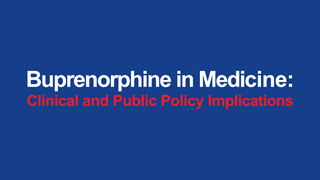Dexmedetomidine as a novel therapeutic for postoperative pain in a patient treated with buprenorphine
DOI:
https://doi.org/10.5055/jom.2009.0018Keywords:
opioid, Precedex, Suboxone, SubutexAbstract
Buprenorphine is a partial agonist/antagonist used for the outpatient management of pain and addiction. It avidly binds to the opioid receptors and has a long and varied half-life. Its effects can impair the efficacy of opioids used for postoperative pain. The authors present a case of a patient managed with buprenorphine as an outpatient who presented for revision spine surgery and had significant postoperative pain that was successfully treated with hydromorphone and dexmedetomidine. This is the first reported use of dexmedetomidine for postoperative pain in a patient treated with buprenorphine.References
Heel RC, Brogden RN, Speight TM, et al.: Buprenorphine: A review of its pharmacological properties and therapeutic efficacy. Drugs. 1979; 17: 81-110.
Reckitt Benckiser Pharmaceuticals I: Buprenex Product Insert. Richmond, VA: Reckitt Benckiser Pharmaceuticals, 2002.
Heit HA, Gourlay DL: Buprenorphine: New tricks with an old molecule for pain management. Clin J Pain. 2008; 24: 93-97.
Johnson RE, Fudala PJ, Payne R: Buprenorphine: Considerations for pain management. J Pain Symptom Manage. 2005; 29: 297-326.
Tigerstedt I, Tammisto T: Double-blind, multiple-dose comparison of buprenorphine and morphine in postoperative pain. Acta Anaesthesiol Scand. 1980; 24: 462-468.
Tyers MB: A classification of opiate receptors that mediate antinociception in animals. Br J Pharmacol. 1980; 69: 503-512.
Walsh SL, Preston KL, Stitzer ML, et al.: Clinical pharmacology of buprenorphine: Ceiling effects at high doses. Clin Pharmacol Ther. 1994; 55: 569-580.
Dahan A, Yassen A, Romberg R, et al.: Buprenorphine induces ceiling in respiratory depression but not in analgesia. Br J Anaesth. 2006; 96: 627-632.
Mercadante S, Ferrera P, Villari P: Is there a ceiling effect of transdermal buprenorphine? Preliminary data in cancer patients. Support Care Cancer. 2007; 15: 441-444.
Boas RA, Villiger JW: Clinical actions of fentanyl and buprenorphine. The significance of receptor binding. Br J Anaesth. 1985; 57: 192-196.
Cicero TJ, Surratt HL, Inciardi J: Use and misuse of buprenorphine in the management of opioid addiction. J Opioid Manag. 2007; 3: 302-308.
Johnson RE, Strain EC, Amass L: Buprenorphine: How to use it right. Drug Alcohol Depend. 2003; 70: S59-S77.
Walsh SL, June HL, Schuh KJ, et al.: Effects of buprenorphine and methadone in methadone-maintained subjects. Psychopharmacology (Berl). 1995; 119: 268-276.
Sessler CN, Gosnell MS, Grap MJ, et al.: The Richmond Agitation-Sedation Scale: Validity and reliability in adult intensive care unit patients. Am J Respir Crit Care Med. 2002; 166: 1338-1344.
Mark TL, Kassed CA, Vandivort-Warren R, et al.: Alcohol and opioid dependence medications: Prescription trends, overall and by physician specialty. Drug Alcohol Depend. 2009; 99: 345-349.
Leppanen MK, McKusick BC, Granholm MM, et al.: Clinical efficacy and safety of dexmedetomidine and buprenorphine, butorphanol or diazepam for canine hip radiography. J Small Anim Pract. 2006; 47: 663-669.
Roberts DM, Meyer-Witting M: High-dose buprenorphine: Perioperative precautions and management strategies. Anaesth Intensive Care. 2005; 33: 17-25.
Alford DP, Compton P, Samet JH: Acute pain management for patients receiving maintenance methadone or buprenorphine therapy. Ann Intern Med. 2006; 144: 127-134.
Glassman SD, Rose SM, Dimar JR, et al.: The effect of postoperative nonsteroidal anti-inflammatory drug administration on spinal fusion. Spine. 1998; 23: 834-838.
Martin GJ Jr, Boden SD, Titus L: Recombinant human bone morphogenetic protein-2 overcomes the inhibitory effect of ketorolac, a nonsteroidal anti-inflammatory drug (NSAID), on posterolateral lumbar intertransverse process spine fusion. Spine. 1999; 24: 2188-2193; Discussion 2193-2194.
Zhang X, Schwarz EM, Young DA, et al.: Cyclooxygenase-2 regulates mesenchymal cell differentiation into the osteoblast lineage and is critically involved in bone repair. J Clin Invest. 2002; 109: 1405-1415.
Altman RD, Latta LL, Keer R, et al.: Effect of nonsteroidal antiinflammatory drugs on fracture healing: A laboratory study in rats. J Orthop Trauma. 1995; 9: 392-400.
Dimar JR, II, Ante WA, Zhang YP, et al.: The effects of nonsteroidal anti-inflammatory drugs on posterior spinal fusions in the rat. Spine. 1996; 21: 1870-1876.
Keller J, Bunger C, Andreassen TT, et al.: Bone repair inhibited by indomethacin. Effects on bone metabolism and strength of rabbit osteotomies. Acta Orthop Scand. 1987; 58: 379-383.
Reikeraas O, Engebretsen L: Effects of ketoralac tromethamine and indomethacin on primary and secondary bone healing. An experimental study in rats. Arch Orthop Trauma Surg. 1998; 118: 50-52.
Sucato DJ, Lovejoy JF, Agrawal S, et al.: Postoperative ketorolac does not predispose to pseudoarthrosis following posterior spinal fusion and instrumentation for adolescent idiopathic scoliosis. Spine. 2008; 33: 1119-1124.
Urrutia J, Mardones R, Quezada F: The effect of ketoprophen on lumbar spinal fusion healing in a rabbit model. Laboratory investigation. J Neurosurg Spine. 2007; 7: 631-636.
Adam F, Chauvin M, Du Manoir B, et al.: Small-dose ketamine infusion improves postoperative analgesia and rehabilitation after total knee arthroplasty. Anesth Analg. 2005; 100: 475-480.
Subramaniam K, Subramaniam B, Steinbrook RA: Ketamine as adjuvant analgesic to opioids: A quantitative and qualitative systematic review. Anesth Analg. 2004; 99: 482-495; Table of contents.
Yamauchi M, Asano M, Watanabe M, et al.: Continuous lowdose ketamine improves the analgesic effects of fentanyl patient-controlled analgesia after cervical spine surgery. Anesth Analg. 2008; 107: 1041-1044.
Cohen SP, Chang AS, Larkin T, et al.: The intravenous ketamine test: A predictive response tool for oral dextromethorphan treatment in neuropathic pain. Anesth Analg. 2004; 99: 1753-1759; Table of contents.
Cohen SP, Verdolin MH, Chang AS, et al.: The intravenous ketamine test predicts subsequent response to an oral dextromethorphan treatment regimen in fibromyalgia patients. J Pain. 2006; 7: 391-398.
Herroeder S, Pecher S, Schonherr ME, et al.: Systemic lidocaine shortens length of hospital stay after colorectal surgery: A double-blinded, randomized, placebo-controlled trial. Ann Surg. 2007; 246: 192-200.
Marret E, Rolin M, Beaussier M, et al.: Meta-analysis of intravenous lidocaine and postoperative recovery after abdominal surgery. Br J Surg. 2008; 95: 1331-1338.
Kamibayashi T, Maze M: Clinical uses of 2-adrenergic agonists. Anesthesiology. 2000; 93: 1345-1349.
Martin E, Ramsay G, Mantz J, et al.: The role of the 2-adrenoceptor agonist dexmedetomidine in postsurgical sedation in the intensive care unit. J Intensive Care Med. 2003; 18: 29-41.
Ramsay MA, Luterman DL: Dexmedetomidine as a total intravenous anesthetic agent. Anesthesiology. 2004; 101: 787-790.
Venn RM, Hell J, Grounds RM: Respiratory effects of dexmedetomidine in the surgical patient requiring intensive care. Crit Care. 2000; 4: 302-308.
Pandharipande PP, Pun BT, Herr DL, et al.: Effect of sedation with dexmedetomidine vs lorazepam on acute brain dysfunction in mechanically ventilated patients: The MENDS randomized controlled trial. JAMA. 2007; 298: 2644-2653.
Riker RR, Shehabi Y, Bokesch PM, et al.: Dexmedetomidine vs midazolam for sedation of critically ill patients: A randomized trial. JAMA. 2009; 301: 489-499.
Sidebotham D, Dijkhuizen MR, Schug SA: The safety and utilization of patient-controlled analgesia. J Pain Symptom Manage. 1997; 14: 202-209.
Downloads
Published
How to Cite
Issue
Section
License
Copyright 2005-2024, Weston Medical Publishing, LLC
All Rights Reserved












